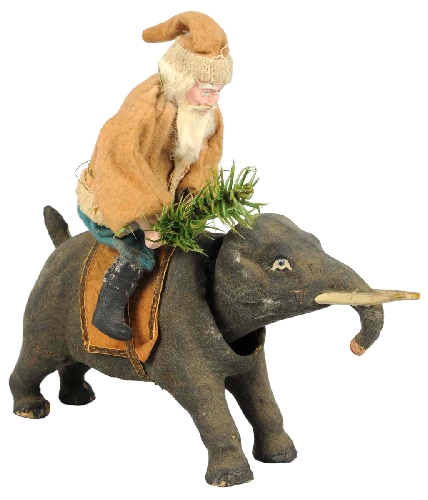Santa’s ‘sleigh’ changes by climate, culture
Santa Claus has changed in appearance throughout the centuries. At first he was St. Nicolas, a tall thin man with a beard. In 1823, the famous poem "The Night Before Christmas" was published. It describes a jolly little man who was small enough to slide down a chimney.
Early Santa figures usually walked with a bag full of toys, but by the 1850s he was riding in a sleigh. Reindeer pulled the sleigh in snowy countries, flying through the air or running on wooded trails.
The legend of Santa Claus bringing toys at Christmas is now worldwide, so Santa's sleigh has been changed to suit different cultures and weather. A child in a tropical climate probably wouldn't recognize a sleigh or reindeer.
Vintage pictures, figures, candy containers and even ornaments can be found with Santa riding more modern vehicles. Horses replaced reindeer. Airplanes, trains, cars and even airships replaced sleigh and reindeer. Toys are carried in a bag or box.
There are even candy containers shaped like a baby elephant with a large Santa riding on his back. Some containers, known as "nodders," depict an elephant with a head that bobs up and down. They are favorites of Christmas collectors.
The nodders, most made in Germany in the 1930s, sell for about $700.
Q: I have a tapered jar with printing on the bottom that has to be read from the inside out. It says "No. 72, Pat. in U.S., Dec. 22, 1903, July 17, 1906, M 29." It's 4 inches high, 2½ inches wide at the top and 2 inches wide at the bottom. The top is grooved, as though it was meant to screw into something.
A: Your jar was part of an old Arcade wall-mounted coffee grinder. There were three parts to the grinder. A different glass jar at the top held the coffee beans and the middle part ground them. The ground coffee emptied into your jar, which screwed into the bottom of the grinder. We found the answer by checking the patent numbers.
Q: My husband has a colorful menu for the 1941 Christmas dinner for U.S. Marines and Navy seamen stationed on Wake Island. What is it worth and how should we sell it?
A: Christmas dinner never took place on Wake Island in 1941 because Japanese forces captured the island on Dec. 23. Americans who survived the December battles for the Pacific island, a U.S. territory, were taken prisoner.
At least one other copy of your menu has been sold online. You could offer it through an auction that sells historic Americana and military memorabilia. Several auction houses in the country specialize in that field. Many are listed in the directory link under "Free Resources" on our website, Kovels.com.
Q: I have inherited a unique combination dining table/pool table from my great-grandmother. She must have purchased it in 1902 or '03, because I found a 1903 magazine ad for the table among her papers. The table, made by the Combination Billiard Manufacturing Co., has five heavy hand-carved legs and is 7 feet long. The ad says this particular style sold for $125, but that other styles were available for $30 to $150. I had the cloth restored and I have the dining table top and the triangle for the balls. But I don't have the cues or balls. Can you tell me more, including the table's value today?
A: Around the turn of the 20th century, pool was enjoying a popularity boom among both men and women. During the same era, furniture manufacturers were becoming excessively creative in combining pieces of furniture. Pool-table beds, pool-table bookcase desks and pool dining table combinations were on the market.
The Combination Billiard Manufacturing Co. of Indianapolis sold combinations like yours during the first decade of the 20th century. An Arts and Crafts model made by the same company at about the same time was up for bid at a fall Rago auction in Vineland, N.J. Presale estimate was $1,500 to $2,000.
Q: I have an old wooden bench with a metal Coca-Cola advertising sign on the backrest. The sign reads, "Drink Coca-Cola" and "Fountain Service." The crossbar on the metal legs is embossed "Fountain Service" on each side. I would like to know if the bench is a reproduction and if it's worth some money.
A: Benches like yours are not exceptionally rare, and we have not seen any reproductions. The benches, which probably date from the mid-1900s, most likely sat outside soda fountains that served Coca-Cola. Single benches sell for $100 to $150, depending on the condition of the bench and of the Coca-Cola sign on the backrest.
CURRENT PRICES
Current prices are recorded from antiques shows, flea markets, sales and auctions throughout the United States. Prices vary in different locations because of local economic conditions.
n Hooked rug, mallard ducks, multicolor, 1900s, 35 by 39 inches, $30.
n Christmas tree, feather, bottle brush, spun cotton candles, ornaments, 1930s, 4 inches, $49.
n Musical Christmas tree, revolving, tinsel, blue, green, pixie elves, Japan, 1960s, 20 inches, $88.
n Tabletop Christmas tree, silver-colored plastic, gumdrop type, two parts, ornaments, box, c. 1949, 11 inches, $110.
n Tramp art doll's dresser, two step-back drawers, three lower drawers, raised diamonds, c. 1900, 23 by 12 inches, $243.
n Cupboard, walnut, open step-back top, two shelves, paneled doors, c. 1800, 80 by 57½ inches, $1,185.
n Art glass vase, flower shape, petal rim, amber, horizontal stripes, red lip wrap, D. Chihuly, 9¾ by 10 inches, $3,819.
Terry Kovel's column is syndicated by King Features. Write to: Kovels, (Las Vegas Review-Journal), King Features Syndicate, 300 W. 57th St., New York, NY 10019.




























